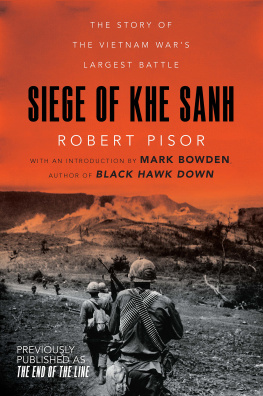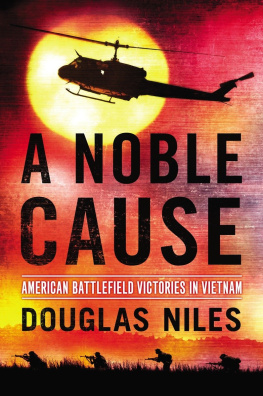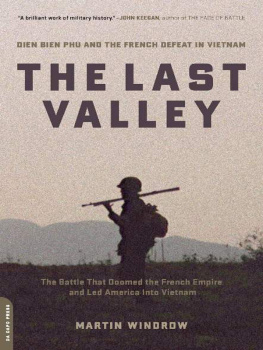
In addition to the authors and correspondents and military personnel whose contributions are acknowledged in the Notes, I am especially grateful for the lively interest of Carolyn Miller, an eyewitness in Khe Sanh whose love for the Bru still glows; for the steady hand of Joseph P. Davison, mapmaker, who uniquely combined the skills of a professional cartographer and an artillery officer, of Rollie Krichbaum, who read the manuscript in its penultimate draft; for the willing assistance of John T. Dyer Jr., Curator of Art at the Marine Corps Museum, and the cheerful competence of the Marine Corps Librarys professional staff, which made me welcome for weeks; for the hospitality of my aunts Doris Baster and Nada Poole, who opened their house and hearts to me during research trips to Washington, D.C.; and for the encouragement and help of my wife, Ellen, whose patience made it possible.




MAPS
Authors and book titles are given here in the clearest abbreviated form. Complete bibliographical details are cited in Sources.
1. THE CURTAIN RISES
In stiff manila folders in a back room of the U.S. Marine Corps library in the Navy Yard, in Washington, D.C., are daily, weekly, and monthly Situation Reports, copies of radio messages, intelligence summaries, cable traffic, casualty totals, and even penciled personal notes from every Marine unit that fought at Khe Sanh. These are the bones of the story of the siege, and they were first put together by Marine Captain Moyers S. Shore II, in The Battle for Khe Sanh.
Shore was under unique pressure; both the Commandant of the U.S. Marine Corps and the Chief of Staff of the U.S. Army looked over his shoulder as he worked. His book was designed specifically to rebut criticism of the decision to stand and fight at Khe Sanhand of the way the fight was fought.
Shores work is flawed by the many official approvals it had to win before publication, but the captain had worked hard to collect the memories and the views of every important player. These records include letters, notes, transcripts of interviews, observations, dissents, and even first drafts of Shores book annotated by officers who served at Khe Sanh. They are invaluable, but uncatalogued, and in Shores notes and in mine they are labeled Comments.
William Dabney, now a lieutenant colonel in the Marine Corps, shared his memories and views during interviews in October and November of 1978 and January of 1980.
A final valued source for this chapter, and for all the siege, was Ray W. Stubbes Chaplain at Khe Sanh, Volumes I and II (a typed manuscript, 1,504 pages, dated 1971, in the Marine Corps library). Stubbes rambling diary is chockfull of eyewitness accounts, wild rumors, and official reports on everything from the weather, the rats, and the Bru to enemy intentions, regimental briefings, and rising casualty tolls.
PAGE
trout as big as salmon: Tompkins, Oral History, p. 48.
the Hill Fights: Shore, pp. 1016.
Were coming after you!: Stubbe, p. 118.
no... target... had been so heavily bombed: Marines in Vietnam1967, p. 125; Shaplen, Road from War, p. 137.
no NVA, no trees, no nothin : Stubbe, p. 120.
We... came back with half [our men]: Congressional RecordHouse, May 22, 1967, pp. 1338182.
well-equipped... well-uniformed, well-fed: Electronic Battlefield, pp. 8081.
all the resources of the Navy, Marine Corps, and Air Force: Pearson, p. 30.
In other words, they bag em.: Chaisson, Oral History, p. 154.
This account of the attack on 881 North comes from Shore, and Dabney, but also from the hand-written accounts of radio operators, enlisted men, and officers who nominated the dead lieutenants for medals. These eyewitness accounts are attached to the formal Award Recommendation forms on file with the Department of Navy. Sergeant Jessup won the Silver Star for his heroism. The Navy Cross was awarded posthumously to platoon leaders Tom Brindley and Michael Thomas.
a... tradition more sacred than life: Small Unit Actions in VietnamSummer, 1966, p.94.
The official history is Shores work, The Battle of Khe Sanh.
2. WESTMORELAND
The details of Westmorelands personal history come from his autobiography, A Soldier Reports, and from Westmoreland: The Inevitable General, by Ernest B. Furgurson. For an understanding of the art of being a general, I am grateful to Maureen Mylanders The Generals.
I attended many of Westmorelands briefings in Vietnam in 1967 and 1968, and twice interviewed him at length as he traveled by jet around the country. I was present at the battles of Con Thien, Loc Ninh, and Dak To, but I am also indebted to the official reports and numbers published by military sources, especially Westmorelands Report on the War in Vietnam.
PAGE
Westmoreland... moved... past West Point classmates: Furgurson, p. 290.
the... best... army in the world: Graff, p. 98.
at the snap of a finger: Furgurson, p. 214.
plane... reeked of monkey shit: Westmoreland, Soldier, p. 27.
the first perfect... compleat general: Mylander, p. 64.
to evoke an image of cascading shells: Westmoreland, Soldier, p. 339.
Checker... onto the board: Westmoreland, Report, p. 160.
daring amphibious hook: Westmoreland, Soldier, p. 204.
chimerical: Westmoreland, Soldier, p. 113.
a jumble of generals: Westmoreland, Report, p. 83, and Kahin and Lewis, pp. 13175.
Big Minh playing tennis: Westmoreland, Soldier, p. 63. Some Vietnamese complained that Westmoreland tended to have greater confidence in Vietnamese who spoke good English regardless of their military or political skills: see Tran Van Don, p. 152.
ARVN: Westmoreland, Soldier, p. 5970.
nozzles... of disabling gas: Soldier, pp. 4647.
trying to push spaghetti: Charleton, p. 135.
talked... with Sir Robert Thompson: Furgurson, p. 296, and Soldier, p. 100.
The critical importance of the little plateau was immediately apparent: Westmoreland, Soldier, p. 336.
rules: Soldier, pp. 4048, and Furgurson, pp. 296300.
forego dissent: Mylander, p. 211.
another six months: Soldier, pp. 6365.
was not... going to fall on my sword: Soldier, p. 77.
drinking... coup leaders under the table: Soldier, p. 99.
In January 1965: This short history of the early war years is from Westmorelands accounts in Soldier and Report, and from the summary in Halberstam, Brightest, pp. 54479.
We must be prepared for a long war: Soldier, p. 139.
field-marshal psychosis: Soldier, pp. 11516. See also Halberstam, Brightest, p. 248.
Full speed ahead types: Furgurson, p. 313.
The Influence of Public Opinion: Furgurson, p. 200.
a forceful player who knew what he wanted: Halberstam, Brightest, p. 576.
the win phase:
Next page









